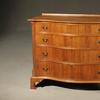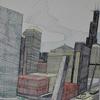NOGUCHI MUSEUM TO HONOR TADAO ANDO & ELYN ZIMMERMAN WITH 2016 ISAMU NOGUCHI AWARD
- LONG ISLAND CITY, New York
- /
- December 03, 2015
The Noguchi Museum is pleased to announce architect Tadao Ando and artist Elyn Zimmerman as recipients of the third annual Isamu Noguchi Award, given to recognize individuals who share Noguchi’s spirit of innovation, global consciousness, and East-West exchange. The awards will be presented during a special ceremony at The Noguchi Museum’s annual Spring Benefit on Tuesday, May 10, 2016.
Jenny Dixon, Director of The Noguchi Museum states, “With the Isamu Noguchi Award, the Museum honors the enduring links between the work of Isamu Noguchi and the many artists and designers he continues to inspire. We are thrilled to present this year’s Isamu Noguchi Award to architect Tadao Ando and artist Elyn Zimmerman, whose approach to their profound and beautiful work shares much with Noguchi’s.”
One of the most important artists of the modern era, Isamu Noguchi (1904–88) ignored the boundaries between art and design, creating sculptures, gardens, furniture and lighting designs, ceramics, architecture, playgrounds, and set designs. His multi-faceted practice included collaborations with some of the most important artists and thinkers of the 20th century, including John Cage, Martha Graham, and Buckminster Fuller, among others. As demonstrated by the Award, artists in all mediums continue to engage with and find inspiration in his work today.
Tadao Ando’s minimalist approach, sensitivity to light, and incorporation of natural elements into his projects, in addition to his fusion of Eastern and Western architecture, are all principles that Noguchi embraced throughout his career. Highly regarded for his unparalleled work with concrete and his creative use of natural light, Ando is known for structures that follow natural forms of the landscape. Like Noguchi’s sculpture, which gave equal importance to the object and the space it inhabited, Ando’s work harmoniously integrates edifice and environment, while interior and exterior are intimately connected through his incorporation of water, light, wind, sky, and landscape into his building designs. Ando learned his first lessons by studying traditional Japanese architecture before learning about modern Western architecture, including the buildings of Le Corbusier, Frank Lloyd Wright, and Louis Kahn. The inspiration he drew from these experiences is evident throughout his work which, much like the museum that Noguchi designed, often provide sanctuary from the clamor of daily life.
Elyn Zimmerman also shares with Noguchi a sensitivity to atmosphere and the incorporation of natural elements into the design of her projects—from public plazas to sculpture gardens on a grand scale. Zimmerman started her career as a painter and photographer, captivated by the ephemeral notion of light and space. A trip to India inspired her to create outdoor works, and her first significant public installation was for the National Geographic Society, in 1980. Like Noguchi, Zimmerman is best known for her use of stone, often in association with water and landscape elements. Her deep appreciation for the emotional resonance of stone and the ways it interacts with the environment has translated into her public and private commissions, which often feature monoliths or channels of rough and polished stone. Like Noguchi, she is a global citizen, and undertakes collaborations around the world.
About the Isamu Noguchi Award
Launched at the Noguchi Museum’s May 2014 Spring Benefit, the Isamu Noguchi Award was established to honor the tenets that Noguchi expressed in his life’s work and to acknowledge other like-minded, highly accomplished individuals who reflect similar ideals in their own times. The Award thus celebrates innovation, global awareness, and Eastern and Western exchange. The two inaugural recipients were architect Lord Norman Foster and artist Hiroshi Sugimoto. In 2015, the Museum honored industrial designer Jasper Morrison and architect Yoshio Taniguchi.
About Tadao Ando
Born in Osaka, Japan, in 1941, Tadao Ando is a self-educated architect. He spent time in nearby Kyoto and Nara, studying firsthand the great monuments of traditional Japanese architecture, and between 1962 and 1969 he traveled to the United States, Europe, and Africa, learning about Western architecture, history, and techniques. His studies of both traditional Japanese and modern architecture had a profound influence on his work and resulted in a unique blend of these rich traditions. In 1969, Ando established Tadao Ando Architect and Associates in Osaka. He is an honorary fellow in the architecture academies of six countries; has been a visiting professor at Yale, Columbia, and Harvard Universities; and in 1997, became professor of architecture at Tokyo University. Ando has received numerous architecture awards, including the prestigious Pritzker Architecture Prize, in 1995; the 2002 American Institute of Architects Gold Medal, the Kyoto Prize for lifetime achievement in the arts and philosophy, also in 2002; the Gold Medal of Union Internationale des Architectes, in 2005; and the Commandeur de l'Ordre des Arts et des Lettres, France, in 2012. His buildings can be seen in Japan, Europe, United States, Mexico, China, Taiwan, Korea, and elsewhere. Among his most notable works are Row House in Sumiyoshi, Osaka (1976); Church of the Light, Osaka (1989); Pulitzer Arts Foundation, St. Louis, MO (2001); Armani Teatro, Milan, Italy (2001); Benesse Art Site Naoshima, including the Benesse House Museum, Chichu Art Museum, Lee Ufan Museum, ANDO Museum, among other projects (1992–2013); Modern Art Museum of Fort Worth, TX (2002); 21_21 DESIGN SIGHT in Tokyo (2007), Punta Della Dogana Contemporary Art Center (2009), Italy; and the expansion of Clark Art Institute in Williamstown, MA (2014).
About Elyn Zimmerman
Born in Philadelphia, Pennsylvania, in 1945, Elyn Zimmerman is best known as a sculptor with an emphasis on large scale, site-specific projects. She started her career as a painter and photographer, and often mixes and matches these mediums in her two-dimensional works. In the mid 1970s, Zimmerman created a number of temporary, site-specific sculpture installations for museum and gallery exhibitions, including at the Museum of Contemporary Art, Chicago; Hudson River Museum, NY; Walker Art Center, Minneapolis; Berkeley Art Museum, Berkeley; Los Angeles County Museum of Art; and Hirshhorn Museum, Washington, DC. Returning to the United States in 1977 after a trip to India (where she was inspired by archeological sites to undertake outdoor projects), she was invited to create temporary outdoor works at places including Artpark, Lewiston, NY; 1980 Winter Olympics, Lake Placid, NY; Laguna Gloria Art Museum, Austin, Texas, and others. Her permanent outdoor projects, beginning in 1980, include a fountain to memorialize the World Trade Center bombing, New York City; the design of the Sculpture Garden at the Birmingham Museum of Art in Alabama; a fountain and seating area for AT&T headquarters in New Jersey; the plaza design, including a large pool and granite sculpture, at the National Geographic headquarters in Washington, DC; a plaza project in San Francisco with multiple water elements and seating areas; and a plaza in downtown Vancouver with sculpture and water elements.
Zimmerman has been awarded with three National Endowment for the Arts fellowship grants and an Excellence in Design Award for Capsouto Park from the Art Commission of the City of New York (2007), among others. She received both undergraduate and Master’s degrees in Art at the University of California, Los Angeles, and taught university-level art classes from 1974 to 1986 in California and New York.
About The Noguchi Museum
The Noguchi Museum occupies a renovated industrial building dating from the 1920s. The first museum in America to be founded by a living artist to show his or her work, the Museum comprises ten indoor galleries and an internationally acclaimed outdoor sculpture garden. Since its founding in 1985, the Museum—itself widely viewed as among the artist’s greatest achievements—has exhibited a comprehensive selection of sculpture in stone, metal, wood, and clay, as well as models for public projects and gardens, dance sets, and Noguchi’s Akari Light Sculptures. Provocative, frequently-changing installations of the permanent collection, together with the Museum’s diverse special exhibitions, offer a rich, contextualized view of Noguchi’s work and illuminate his influential legacy of innovation. www.noguchi.org
















